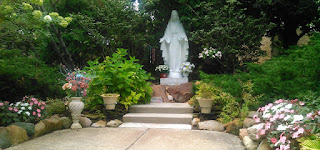Dominican nuns arrived in the U.S. in 1880 and, in 1905, Mother Mary Emmanuel petitioned Bishop John S. Foley to come to Detroit and the bishop accepted without hesitation. Mother Mary Emmanuel and seven nuns temporarily resided in the Murphy Mansion, at Woodward and Kirby in Midtown. Parishioners from Holy Rosary Church (now Our Lady of the Rosary) joined the nuns in Adoration.
 |
| Murphy Mansion. Burton Historical Collection, Detroit Public Library |
September 4, 1908, saw the groundbreaking for Monastery of the Blessed Sacrament at 9704 Oakland Avenue. In 1910, the Dominicans moved in when the monastery was still half-finished. The cornerstone of the chapel was laid on June 25, 1911, and Bishop Foley led a fundraising effort.
On March 25, 1912, the Feast of the Annunciation, the chapel was formally dedicated by Grand Rapids Bishop Edward D. Kelly. A few years later, three blocks west, Cathedral of the Most Blessed Sacrament would be built.
Dominicans continued to grow and expand in the United States. On November 21, 1915, seven nuns, including Mother Mary Emmanuel, left Detroit to establish another monastery in Albany, New York.
The community had petitioned the Holy See as early as 1923 for the privilege of taking Solemn Vows but for some reason this was not granted until December of 1929. The document granting the permission arrived on Christmas Eve of that year but it was deferred until April 30, 1930 when Bishop Gallagher himself received the Solemn Vows of the Prioress, Mother Mary of the Sacred Heart who, in turn received the Solemn Vows of each of the remaining 21 members of the community.
There were more than 50 Dominican nuns in Detroit when Mother Mary Imelda was elected prioress in 1944, the decision to make a new foundation was reached. Mother Mary Imelda herself led the group of 15 foundresses to a new site in Lufkin, Texas where the Monastery of the Infant Jesus, begun in 1945, continues to thrive.
During the 1950s, the monastery's structural condition deteriorated beyond repair. Mother Mary of Jesus Kalt was the Prioress at the time, she asked Cardinal Mooney for advice and permission to move. Cardinal Mooney gave his blessing and encouragement to launch fundraising. Additionally, he donated the land where the monastery now stands at 13 Mile & Middlebelt in Farmington Hills. Cardinal Mooney died in 1958 and was replaced by Archbishop Dearden, who later became a cardinal, and Dearden continued the fundraising efforts. An extern named Sr. Mary Louis de Montfort contacted prominent businessmen, they decided to hire a professional fundraising firm and the “Challenge Campaign” began in early 1964.
A groundbreaking ceremony took place on August 16, 1964 but the cornerstone was not laid until June 27, 1965. Twenty one sisters had lived and died on Oakland Avenue; they were buried in the vaults beneath the Detroit monastery and were transferred to Southfield's Holy Sepulchre Cemetery in 1965.
On June 17, 1966, the nuns relocated to the new monastery in Farmington Hills. On July 1, 1966, then the Feast of the Precious Blood, Archbishop John F. Dearden arrived to celebrate Mass and conduct the dedication ceremonies. He was assisted by Fathers Joseph Imisch, Thomas Gumbleton and Walter Schoenherr; all three priests would alter become bishops. The Dominican provincial, Fr. Albert Drexelius, OP, preached the homily. The Detroit monastery was later razed and an elementary school currently stands at the site. In 2006, the centennial of their arrival in Michigan, the nuns published Monastic Milestones, an exhaustive history of the community.
Blessed Mother statue and prayer garden on the monastery's south side
The chapel is divided in half. The public sits in the front section nearest the parking lot while the sanctuary separates the public from the cloistered nuns.
Statues of the Blessed Virgin Mary and St. Joseph hang on the walls of the nave
Windows from the façade (left) as well as sides (right) of the chapel
The chapel is open daily from 6:45am-5:00pm, including daily Mass at 7:15am and Vespers at 4:30pm
The nuns financially support themselves, in part, by operating a religious gift store
Statues of the Infant of Prague and St. Dominic at the front of the store





























No comments:
Post a Comment